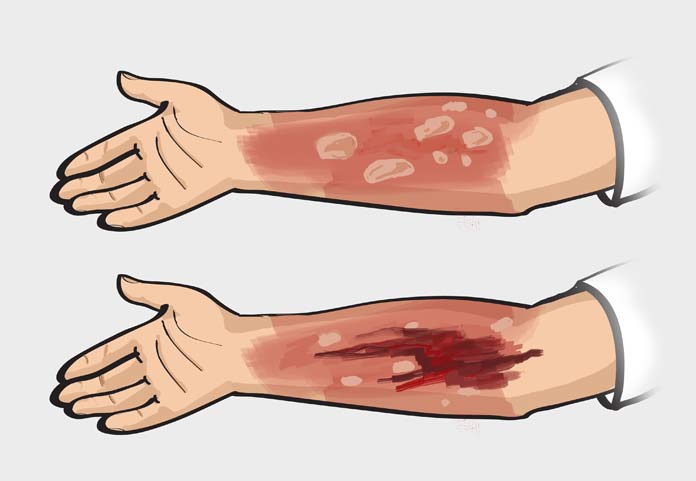Yes, you can sue a company for chemical burns if your lawyer finds sufficient evidence to prove that company is legally responsible for your injuries. If your burns happened at work, your lawyer will need to determine if a corporation that is not owned by your employer is at fault. This is because workers’ compensation laws will most likely prevent you from suing your employer for pain and suffering compensation, which can be significant in these cases.
Lawyers Help Chemical Burns Victims Get Compensation
Eric Hageman and his team of burn attorneys help victims and their families hold corporate wrongdoers accountable. Contact Eric for a free consultation here. If you hire an attorney at our law firm, we will immediately investigate your case. Because it is best to gather evidence soon after an accident, it is important to contact us as soon as possible. You can contact our law firm using the form below.
Any chemical burn, no matter the size, is considered severe and warrants treatment because of the difficulty in stopping the burn and the ability for the chemicals to penetrate and cause dangerous secondary effects.
Before they are treated, chemical burns must be stopped. This is usually done by flushing the area with large volumes of water until the chemical is dilute enough to stop reacting with the skin. If the chemical is dry, such as lime powder or cement, it should be gently brushed off the skin before flushing.
Flushing of the wound can begin at home before paramedics arrive. Garden hoses and showers are the usually the best ways to deliver large volumes of water quickly (Mozingo et. al.). Sometimes, such as in the case of alkali (base) burns, flushing may be needed for several hours. Chemical specific neutralizing agents are not used because the precise chemical may not be known, and reactions with neutralizing agents produce heat, causing even more damage.
Injuries to the eye warrant special action because of the potential of vision damage or blindness. This is especially a concern with alkali burns. Contact lenses should removed, followed by immediate flushing of the eye with water. Flushing should continue until the injury can be evaluated by an ophthalmologist.
Even if flushing was done prior to arrival at the emergency room, it is continued for the next half an hour to hour. This is of utmost importance to prevent or reduce vision loss. Because of the pain associate with burns, especially to the sensitive areas around the eye, the victim may close their eyelids. But they must be held open while flushing to maximize chemical removal and dilution.
Emergency departments have a special tool called the Morgan catheter that forces the eyelid open and aides in the flushing process.
Once stopped, the burn is treated just like other burns with stabilization of the airway, breathing, and circulation.
What are Chemical Burns?
They are caused by substances such as acids, bases, and hydrocarbons. The severity of the burn depends on the concentration of the substance, the length of exposure, and the type of chemical causing the damage. Typically, the chemicals continue to damage the skin until they are neutralized or diluted with water.
The main mechanism of tissue damage caused by acids and bases is through protein coagulation. There are three main types of chemical agents that cause burns, each acting by a different mechanism.
- Acids, such as those in industrial cleaners and rust removers are oxidizing agents or corrosive agents. Oxidizing agents add oxygen to proteins, which changes the structure and thus the function. Corrosive agents denature protein through various mechanisms.
- Bases (or alkalis) such as lime, potassium hydroxide, sodium hydroxide, cement, or household cleaners like ammonia, act as reducing agents or desiccants. Reducing agents denature proteins by breaking the bonds between the amino acids that make up the protein. Desiccants extract water from tissues through a heat-producing reaction, causing both chemical and thermal burns.
- Hydrocarbons, such as solvents, degreasing agents, and gasoline act as protoplasmic toxins (they kill cells).
What Types of Chemical Burn Injuries are Caused by Chemical Burns?
Acids and bases are the two most common types of chemical burns as they are found in various household products that people do not typically assume to be dangerous. Bases (alkalis) actually cause more severe tissue damage than acids because they essentially liquefy the skin which allows the base to penetrate deeply into the tissue. Acids cause coagulation necrosis which prevents deep penetration of the acid.
If the chemical is in a gaseous form, it can cause direct injury to the lungs and respiratory system. Direct pulmonary damage is even worse because it can lead to epithelial sloughing (the skin lining the airway falls off), cast formation (tissue clumps resulting from dead tissue and scar tissue), or alveolar collapse. Even if the agent only causes external skin damage, it can also indirectly cause respiratory complications because the chemicals may trigger the release of histamine which can cause swelling or bronchospasm. For more information on inhalation injuries, see our page on inhalation injury.
Sometimes the chemical may be absorbed into the tissue, which may cause secondary injuries. Some cause myocardial depression (the heart does not pump as well), which results in a decrease in the blood pressure. This can result in blood not being properly distributed through the body.
Two areas particularly affected by the shock and low blood flow are the kidneys and liver. With the low blood flow, chemicals or wound debris can become trapped in both the kidneys and liver.
Hemodialysis may be required to remove the toxins that build up.
Sources:
1. Mozingo DW, Barillo DJ, Ruitt BA Jr: Acute resuscitation and transfer management of electrically injured patients, Trama Q 11(2):94-113, 1994.
3. Digital Journal of Opthamology.

